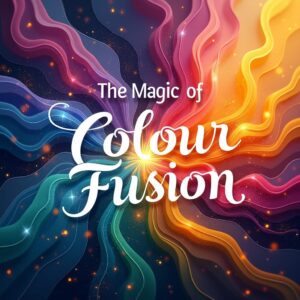
Colour is one of the most powerful tools in art, design, and communication. The right combination of hues can evoke emotions, create harmony, and even influence decisions. “Colour Fusion” is the art of blending shades in a way that captivates the eye and tells a story. Whether in fashion, branding, interior design, or digital media, mastering colour combinations can transform the ordinary into the extraordinary.
The Science Behind Colour Fusion
Colour theory, pioneered by visionaries like Isaac Newton and Johannes Itten, explains how colours interact. Key concepts include:
- The Colour Wheel – A visual representation of primary, secondary, and tertiary hues.
- Complementary Colours – Opposites on the wheel (e.g., blue & orange) that create contrast.
- Analogous Colours – Neighbouring hues (e.g., blue, teal, green) for smooth transitions.
- Triadic & Tetradic Schemes – Balanced yet vibrant palettes using three or four colours.
Understanding these principles helps designers and artists fuse colours in ways that are visually striking yet harmonious.
The Emotional Power of Colour Combinations
Different hues evoke different feelings:
- Warm Colours (Red, Orange, Yellow) – Energy, passion, and excitement.
- Cool Colours (Blue, Green, Purple) – Calmness, trust, and sophistication.
- Neutrals (Black, White, Grey, Beige) – Balance and timeless elegance.
By blending these intentionally, creators can set moods—whether it’s a bold, dynamic advertisement or a serene, minimalist living space.
Applications of Colour Fusion
1. Fashion & Styling
- Monochromatic Looks – Different shades of one colour for sleek sophistication.
- Contrasting Accents – A pop of complementary colour to make an outfit stand out.
- Seasonal Palettes – Soft pastels for spring, rich jewel tones for winter.
2. Graphic & Web Design
- Brand Identity – Consistent colour schemes that convey a company’s values (e.g., blue for trust, green for eco-friendliness).
- Readability & Hierarchy – High-contrast text and background combinations for better user experience.
3. Interior Design
- Mood-Based Rooms – Warm tones for social spaces (living rooms), cool tones for relaxation (bedrooms).
- Accent Walls & Decor – Strategic use of bold colours to create focal points.
4. Art & Photography
- Colour Blocking – Bold, contrasting sections for dramatic effect.
- Subtle Gradients – Smooth transitions for a dreamy, ethereal look.
Tips for Mastering Colour Fusion
- Start with a Base Colour – Choose one dominant hue and build around it.
- Use the 60-30-10 Rule – 60% dominant, 30% secondary, 10% accent for balance.
- Experiment with Tools – Adobe Colour, Coolors, or Pantone guides can help generate palettes.
- Consider Lighting – Colours change under natural vs. artificial light; test before finalizing.
- Trust Your Instincts – Sometimes, unexpected pairings create the most magical results.
Conclusion
Colour fusion is more than just picking pretty shades—it’s about creating visual harmony, telling stories, and evoking emotions. Whether you’re a designer, artist, or simply someone who loves aesthetics, mastering the magic of hues can elevate your work from good to unforgettable.